In this post are encounters with Thay shared by our monastic siblings and friends, who have offered these stories as a gift to celebrate Thay’s continuation day (October 11).
If you have Thay’s Dharma joy and Thay’s happiness in every step, in every breath, then even though in appearance you may not look like Thay, but inside you are a true continuation of Thay. This is why the practice of “signlessness” in the Three Doors of Liberation is so important in helping us recognize true continuation.
Thay
An open door for transformation
Dr. Lilian Cheung
I will never forget one evening over dinner when my oldest son was trying to share the challenges he was facing at school. Of course, my mind was totally elsewhere, preoccupied with work. Suddenly, I heard him saying: “Knock, knock, Mommy. Are you there?” The moment pierced my heart as I could not even be fully present for my son. I recognized that change was necessary. As I was suffering from sleep deprivation and mounting worries, I found myself becoming more withdrawn with feelings of emptiness and hopelessness. I had reduced interest in activities that I once enjoyed and did not have enough energy to attend to my endless to-do list as I was constantly fatigued.
In the fall of 1997, I received a flyer announcing a special seven-day retreat on the teachings of Buddhist psychology, Opening the Door to Healing & Transformation by Thich Nhat Hanh. I did not know who Thich Nhat Hanh was, but my mind returned to my son’s “knock, knock” plea years earlier. I figured this was definitely a door I should open!
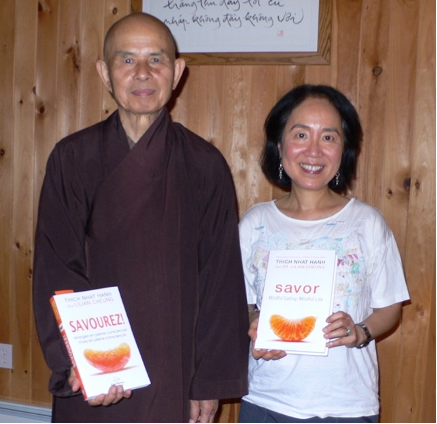
Thay appeared on stage walking calmly towards his cushion. Without even hearing him speak and through only his presence, I recall my initial impression of Thay as a divine being. As I listened to his words and lessons, I began to feel a shift within myself. In one Dharma talk, Thay taught us that suffering is always there. “We need to look deeply in the ill-being and find a way out. We cannot escape it. Happiness and well-being must be found in the heart of suffering.” Having been a worrier my whole life and often finding it difficult to be happy, I was moved by this lesson.
That afternoon, Thay asked us to reflect on five questions: 1. What conditions do I think I still need to be happy? 2. If the conditions can never be realized, would I be unhappy all my life? If so, what would I do about it? 3. What makes me happy right now? Write down the elements of happiness that are available in the present. 4. What kind of arrangement can I make to recognize these elements in my daily life to benefit from them? 5. For what is not to my liking now, what can I do to make it more acceptable to me?
The retreat was completely transformative for me, and it seemed to be healing for others as well. When Thay bid farewell to us at the end of the Key West retreat, he made a special comment, “Many of you may have touched some peace in this retreat, but if you return home and do not practice, you will lose all your peace.” This message became deeply rooted in my brain and I set out to apply his advice in my life at home. I began to practice mindfulness daily—even if I could only manage for only three percent of my waking hours to start. However, eventually a habit began to form, and I was increasing my degree of mindfulness practice year after year!
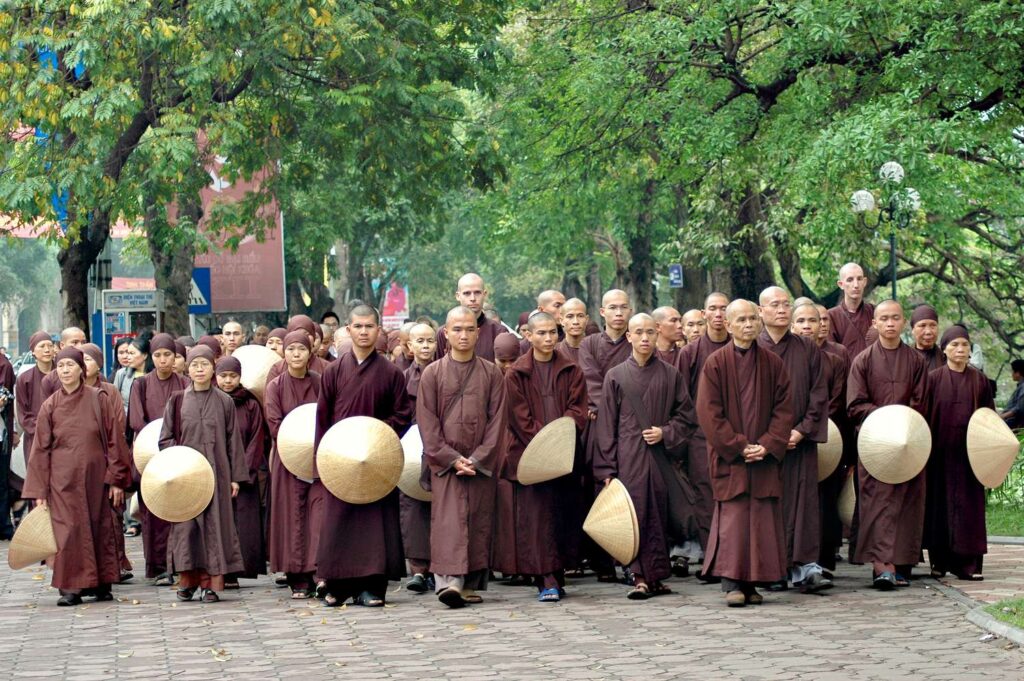
“Just look at Thay”
Br. Pháp Lưu
I felt so nervous the first time I attended Thay, following Thay back to Sitting Still Hut after the Dharma talk, and I tried to make myself – a tall Westerner – as small as possible in the corner between the kitchen and main room. Thay must have sensed my anxiety; when he came out from the kitchen, he laid the palm of his hand on the middle of my back. My whole body relaxed and felt at ease. Many times since then, when I have felt overwhelmed by an emotion, I just remembered Thay’s hand on my back and, I relax right away.
Once, when I accompanied an elder brother to massage Thay at the Hermitage, Thay pulled a Sanskrit copy of the Buddhacarita by Asvagosha off the shelf for me to read while the massage was going on. It is a complex poem, even for those who know a bit of Sanskrit, but thanks to Thay’s gesture I have come back to it numerous times through the years, learning from the passages on Siddhartha Gautama’s renunciation of sense pleasures.
I was the youngest monk to follow Thay to Vietnam in 2005. In Hanoi, one of the elder brothers told me to “just look at Thay” whenever I didn’t know what to do. This worked wonders to a young novice who had never been in Asia before.
One night, in the first week, we got off the bus in a town near the outskirts of Hanoi to visit a temple of a nun – a student of Thay who had been to Plum Village. The road was narrow leading to her temple, and the sun was setting; we would have to walk about one kilometer to arrive there. I felt anxious for Thay; everything was so new and unusual for me in Vietnam, and I feared that someone might hurt Thay. Walking close to Thay, though, I felt no fear. Thay had been through so much, and practiced so deeply, that he was not afraid of being hurt or dying. Whenever fear or anxiety comes up in me, I remember Thay’s fearlessness in that moment, as Thay led the delegation through the winding dark roads, and my fear dissolves.
Going the extra mile
Jack Lawlor
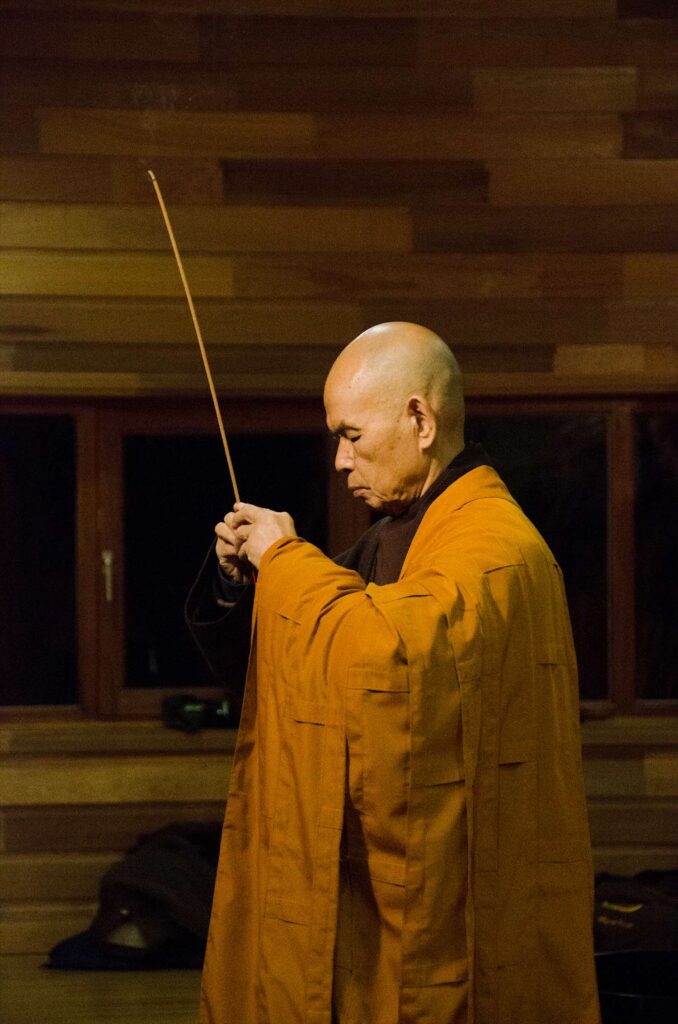
My favorite story about Thay’s teaching by example dates back to 1989, when my young family collectively organized a very active week for Thay in Chicago, involving a Dharma talk for over 1,000 people of all ages at a local Thai Buddhist Temple, and a weekend retreat in a Chicago suburb for about 90 people, including many children.
As a precaution, we hired a very personable college-age babysitter to help us with the children’s program. But as the retreat continued, she became so swept up by Thay’s talks that she stopped helping us with the children! So, my wife Laurie missed the retreat’s Five Mindfulness Trainings ceremony on the last day of the retreat and played with the children instead.
When Thay learned what had happened, and how Laurie had missed the ceremony, while we drove back together from the retreat center to our house, Thay had an idea. We would have a Five Mindfulness Trainings ordination for Laurie at our house that evening, followed by an ice-cream party. This after such a busy week for Thay!
Once home from the retreat, after a rest, Sister Chan Khong, our very young children, our Labrador retriever and me assembled in our modest living room. Thay descended from the bedrooms upstairs, not just in his brown robe, but in his full ceremonial robe! I thought he might do an abbreviated version of the Five Mindfulness Trainings, but he did the entire ceremony, which for me seems to resonate in that room in our modest house to this day. Whenever needed, I can evoke a crystal clear memory of his recitation of the incense offering verse based on that evening together.
A master gardener
Sr. Thệ Nghiêm
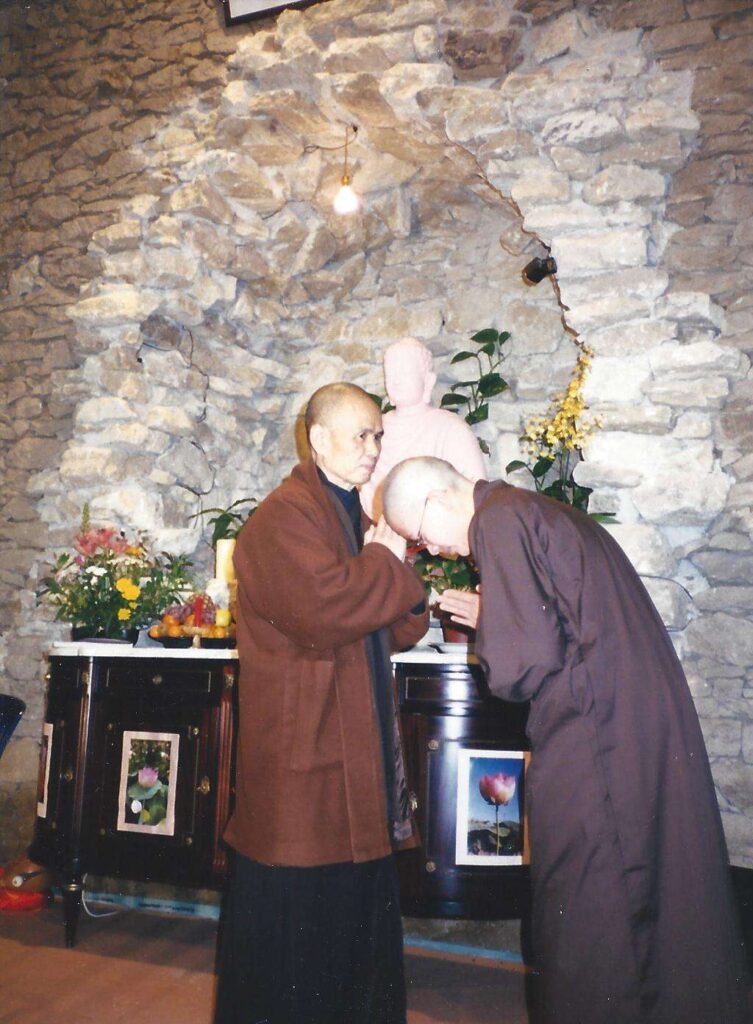
Thay has often been likened to a master gardener. He skillfully cultivated the vast and varied nursery of our sangha with the nurturing and affirmative qualities of a loving teacher. Thay steadfastly tended to the shoots and leaves of our practice. Even more fundamentally, however, he gave careful attention to the sometimes dormant seed of faith in us, helping us awaken confidence in our own Buddha nature. Through his understanding and trust, Thay watered this seed of faith in me. Because of this, I was able to awaken to the goodness within and around me.
Once, at the Hermitage, in a space of quiet, Thay brought me to a flowering plant whose blossom had not yet open. Teacher and disciple observed the plant quietly. Then Thay said, “Everyone is like that flower, my child. It unfurls its petals in its own time, when it is ready.” In that moment, I felt Thay’s understanding and acceptance of my reserve and diffidence to him as his disciple. At the same time, I felt his skillful encouragement: allow yourself to bloom.
Thay’s nurturing and affirmative ways are such a breath of fresh air in our world. The public discourse and social climate of today are often filled with skepticism, cynicism, and hurtful speech. In this toxic milieu, the self-confidence of our youth, and their faith in others, can easily be wounded. Our young ones especially need heartfelt affirmation of their goodness, and a vision of a wholesome path. How else will their inner and outer faith take root? Early and steadfast nurturance like Thay’s can lead them away from despair, and even save their lives. It can give them the self-confidence to face and overcome their suffering, to transform hurt into understanding and compassion. This kind of nurturance was the gift that Thay gave us.

Climbing the hill of the century
Sr. Thao Nghiêm
In the autumn of 2014, Thay was recuperating in Upper Hamlet and the attending brothers and sisters stayed there with him. One morning at four o’clock, Thay rang a small bell to call us. Myself and another sister went over to Thay’s hut to see if he needed any help. Brother Phap Ao—who slept in the same room with Thay—let us know that Thay wanted to go and visit the monks’ residence. I was a bit surprised, and asked again:
“Now, dear Thay? But the wake-up bell hasn’t been invited yet. The sangha is surely still sleeping.”
Thay said:
“Just get ready, my child. We are going to surprise the brothers. Call the other (attending) brothers and sisters to come also. We have to be quick to be on time. It’s only fun if we arrive before the brothers have risen.”
Promptly, our group of brothers and sisters followed Thay into the monks’ residence before everyone had time to wake up. Thay told the sisters to bring two pots of chrysanthemums as gifts for the brothers. The attending brothers pushed Thay’s wheelchair, while the sisters carried the flowers behind, up all the steps of the Sitting Still Hut, out of the woods. The path from the bell tower to the monks’ residence was still pitch-dark before five in the morning. Above us was the vast starlit sky. Thay cried out in amazement, “Oh my, so beautiful, so wonderful! Thank you Buddha and ancestral teachers for giving me this opportunity. It has been a long time since I’ve had the chance to see this again.” All of us were touched and cherished this chance to enjoy the mystery of the early morning earth and sky.
When we arrived at the monks’ residence, indeed the brothers were not awake yet. Thay enjoyed entering a few rooms to wake up the brothers and give them a surprise. Then we went to the library to drink tea and spend time with the brothers. Thay asked after them, told stories and even sang a song. He also did not forget to offer the two pots of chrysanthemums to the monks’ residence. It was truly a happy and cozy moment. All those close to Thay knew that this required more energy than Thay’s health allowed, but nevertheless he was happy. Thay is very much nourished by the love between teacher and students, and always wanted to bring peace of mind to his students.
Dear respected Thay, we are with you at the top of the hill, sitting peacefully together, breathing with the same rhythm, smiling and looking at the wonder of earth and sky. With Thay in my heart, I see that I have enough, I am strong, rich, and warm.
Whenever I am immersed in the heart of the sangha, I remember Thay’s old dream–to build a kind sangha that has brotherhood and sisterhood, and the substance of the practice. Dearest Thay, perhaps your dream from long ago has been realized? That dream has become our present and will be so for our younger siblings and for everyone in the future.
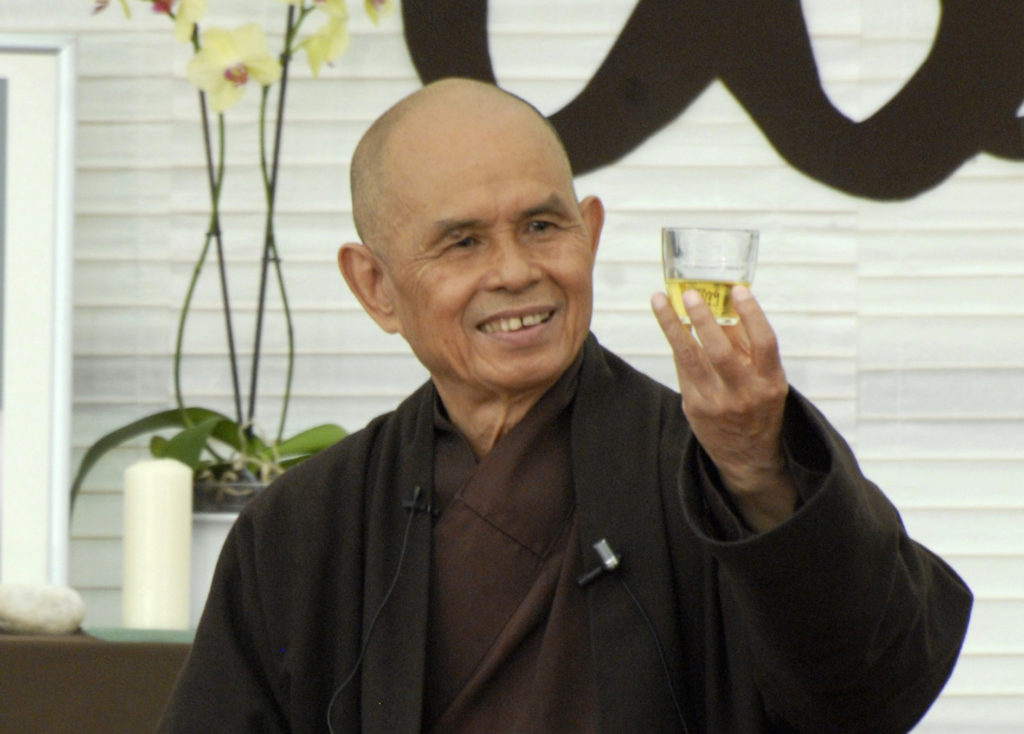



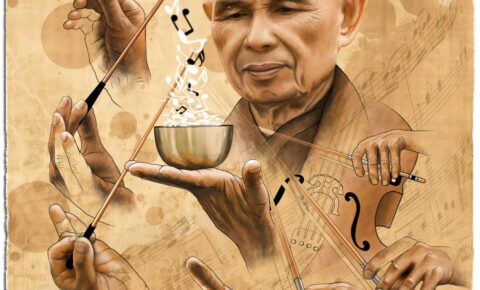
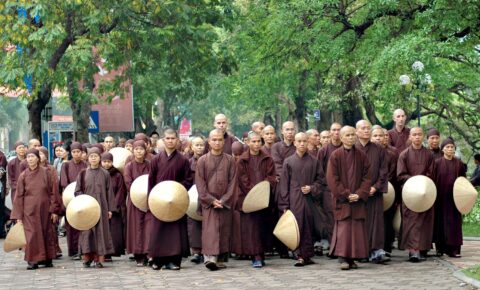
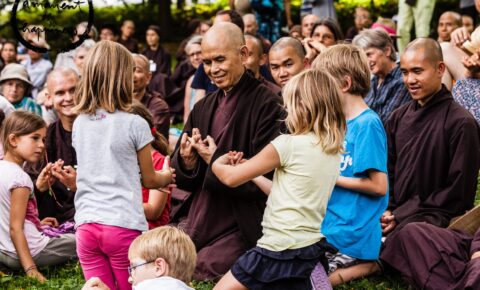
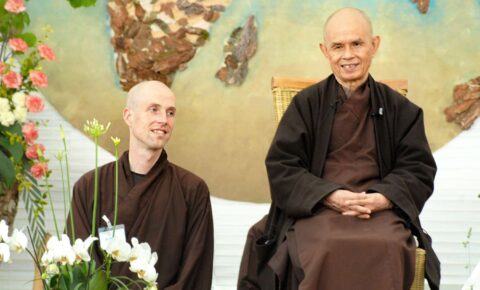
Share Your Reflections